Debt, Decline and the New World Order
Principles for Canadians in a Changing World Order
We are at a pivotal point in history where global power and social structures are shifting dramatically, as outlined by Ray Dalio in his analysis of big historical cycles. This shift also lines up with Howe & Strauss' cycle thesis in The Fourth Turning. Most of these seminal works analyze these historical cycles from an American perspective. However, I looked through the data so Canadians can clearly understand our position within these cycles to navigate the next decade effectively.
Canada’s Place in the Big Cycle
Historically, Canada has thrived as part of the post-WWII, U.S.-led Bretton-Woods world order that set the USD as the global reserve currency and the US military as the policeman of the world, keeping trade routes safe and letting partners focus more on investing in manufacturing, technology, and productivity gains than military and defence. Unlike the U.S., Canada hasn’t been a global hegemon but rather a stable, prosperous secondary power with distinct strengths and vulnerabilities. Understanding these dynamics is crucial for maintaining personal safety, financial stability, and encouraging Canadian prosperity amidst global turbulence.
Debt and Financial Stability
Canada’s debt dynamics reflect a concerning picture:
Public debt is high but not as high as the U.S. (~103% GDP). It’s critical that Canada re-establish fiscal discipline to avoid the debt traps faced by other developed economies, particularly the U.S. (~120% GDP), which enjoys world reserve currency status unlike the CAD.
Private debt is alarmingly high, especially household debt (~185% of disposable income), significantly higher than U.S. household debt (~102%). This vulnerability could lead to instability if housing markets or employment suffer shocks in a changing world order.
In order to avoid moving into the next phase of decline, Canada needs to deleverage carefully while prioritizing the unleashing of its resource and energy sector for progressive and thoughtful economic growth, encourage more private investment to catch up to the U.S. in productivity, and shrink the size of government by enacting fiscally responsible policies to mitigate the risks of a debt crisis.
Internal Stability and Cohesion
Canada enjoys relative internal stability compared to the deeply polarized U.S. However, rising extremism, political divisions, and regional East-West tensions around equalization payments and energy sovereignty are early signals of stress. Preserving Canada’s cohesion involves respecting provincial autonomy and proactively addressing economic disparities caused by excessive borrowing, government debt, and artificially low interest rates.
Raw Deal: Over the last 10 years, Albert has contributed $150–$250 billion MORE in equalization payments to the east than it receives in federal transfers. In contrast, Quebec is up more than $300 billion! As a result, East-West tensions are at all-time highs, threatening Confederation as we know it.
Canada needs to protect core democratic institutions from foreign interference, restore balanced news delivery to avoid left-right polarization from media bias, and pursue centrist policies that appeal broadly. Dalio’s framework emphasizes internal stability, cohesion, and the severity of internal conflicts as indicators of where a country stands in its cycle of decline. One sign of U.S. stability being further along in the decline phase than Canada is the characteristics of the capital protests.
Compared to the U.S. Capitol riot—which turned violent, damaged property, and targeted core government institutions—Canada’s Freedom Convoy, while certainly disruptive, remained peaceful and never posed a direct threat to the functioning of government.
Economic Productivity and Innovation
Canada’s economic Achilles' heel is productivity, consistently lagging behind the U.S. (Canadian productivity is ~70% of U.S. levels). To thrive amidst the changing order, Canada must decisively address this productivity paradox through targeted investments in technology, innovation, and business incentives.
Since the Canadian government's pandemic response, the public sector has grown to an unhealthy level while entrepreneurship and the private sector have lagged, which shows in Canada’s decline in productivity over the last decade.
The Canadian government has ballooned in size in an attempt to prevent stagflation, creating a disparity between public and private sector work and hurting entrepreneurship. Even economists say this trend can’t last; like Canada's growing debt, it’s totally unsustainable.
Education and human capital remain strengths for Canada as we rank top in OECD tertiary education attainment, although it’s debatable whether or not this has contributed to the unhealthy size of Canada’s private debt.
Despite ongoing concerns around mass immigration, Canada has drawn in a highly skilled immigrant workforce—many of whom struggle to find employment in their fields due to outdated and restrictive regulations. Too many foreign-trained doctors and tradespeople have to seek employment in Canada, doing menial jobs outside of the field of their expertise. Converting this educated workforce into greater productivity and innovation outputs must become a national priority.
Reserve Currency and Financial Markets
Canada benefits indirectly from the U.S. dollar’s global reserve status, insulating it from some global shocks. However, Canada’s currency accounts for only ~2.5% of global reserves, offering limited monetary autonomy. Canada must maintain robust and credible fiscal and monetary policies to sustain CAD stability and bond investor confidence in a turbulent global economy. In later stages of Ray Dalio’s cycle of decline, central banks monetize government debt. The Bank of Canada was among the most aggressive central banks in this regard, and Canada saw one of the more rapid expansions of debt relative to GDP among our G7 and G20 counterparts.
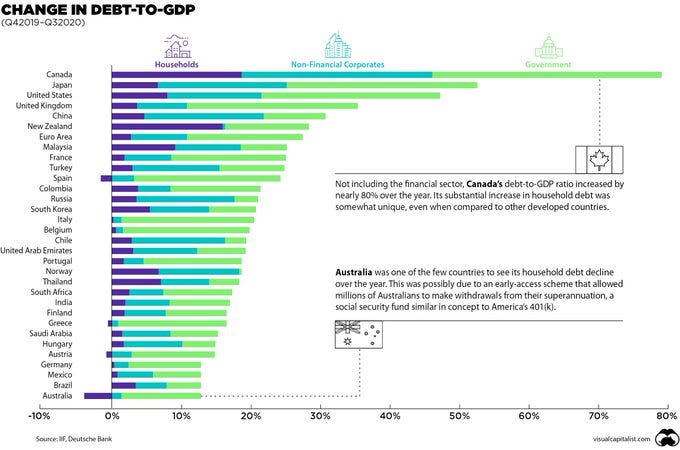
With government-induced lagging GDP growth, a middle power non-reserve currency, and lagging productivity, why would global investors choose to invest in Canadian bonds when it’s almost certain that the dollars they will be paid back with at maturity will have declined in purchasing power?
Canadian bonds have lost 30% of their value since 2020, contrasted with Bitcoin, which is the opposite - a decentralized, non-sovereign, capped-supply digital commodity that has gained 700% since 2020.
Military Strength and Geopolitical Stability
Canada’s defence posture is below modest, relying heavily on U.S. protection through NATO and NORAD. With rising geopolitical tensions, especially U.S.-China-Russia dynamics, Canada needs clarity about its strategic dependencies and should increase defence capabilities to protect national interests, especially in the Arctic, while strengthening alliances.
Navigating the Changing Order
So, what’s the plan of attack? Canada needs to make five big moves:
Strengthen its resilience against internal polarization.
Address a potential private debt bubble burst.
Prioritize productivity and innovation to enhance economic competitiveness through supporting entrepreneurship and the private sector.
Clarify and modestly strengthen its military posture.
Re-accumulate reserve assets such as gold and bitcoin.
Conclusion
Canada now finds itself somewhere between Stage 4 (“Excesses and widening of wealth and other gaps”) and Stage 5 (“Bad financial conditions and intense conflicts”) in Ray Dalio’s cycle of national rise and decline—showing early signs of slipping further into Stage 5. We’re entering a turbulent global era marked by the erosion of American dominance, escalating geopolitical friction, and a shift toward debt deleveraging, economic conflict, artificial scarcity, and a more resource-driven world order. As a relatively stable middle power, Canada has both the opportunity—and the urgent need—in this new age of tariffs and fractured alliances to strengthen our internal foundations and reassert interprovincial cohesion.
The ability to shrink the size of the government to a manageable level, detox from debt, sustain internal cohesion, improve productivity, and navigate geopolitical complexities will define Canada’s success in the unfolding cycle. As Canadians, we should learn from history to recognize that we are in a fourth turning. We need to act decisively to protect ourselves, our businesses, and our communities while maintaining that pragmatic Canadian flexibility and empathy that has allowed us to secure prosperity in the past to carry us through the coming era of global transition. Canada needs a fundamental course correction to avoid sliding deeper into decline—because unlike the U.S., we don’t have the cushion of global hegemony or a reserve currency to soften the fall. If we don’t act, our decline will not happen as slowly or gracefully.
Below is a comprehensive comparative analysis of where Canada currently stands compared to the USA using Dalio's key factors from his books.
Note: Cycle phases are approximate interpretations under Ray Dalio’s framework. The U.S. has characteristics of a power in decline/disorder, whereas Canada, not a former world hegemon, is more of a stabilized middle power (its “cycle” is tied to the broader Western order’s health).



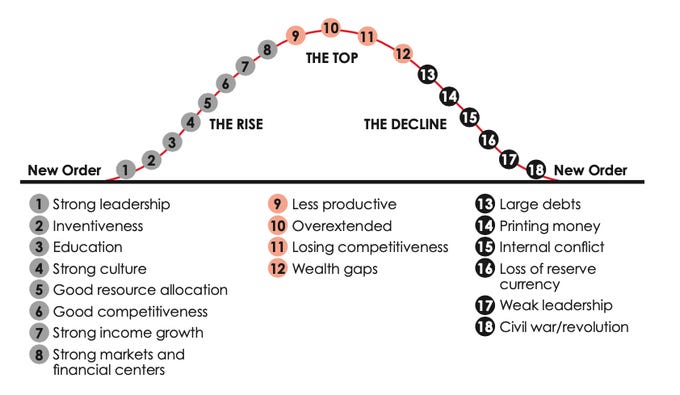
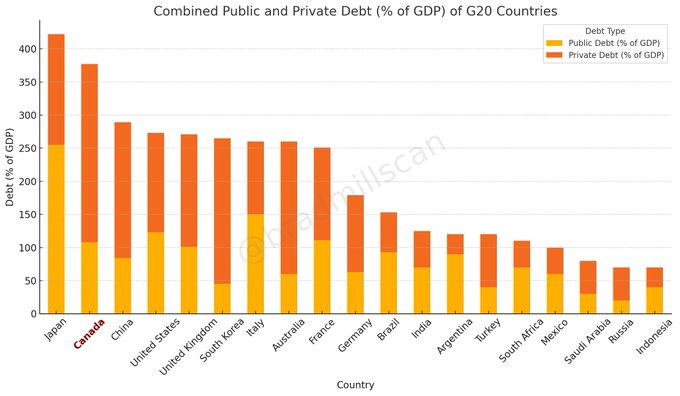
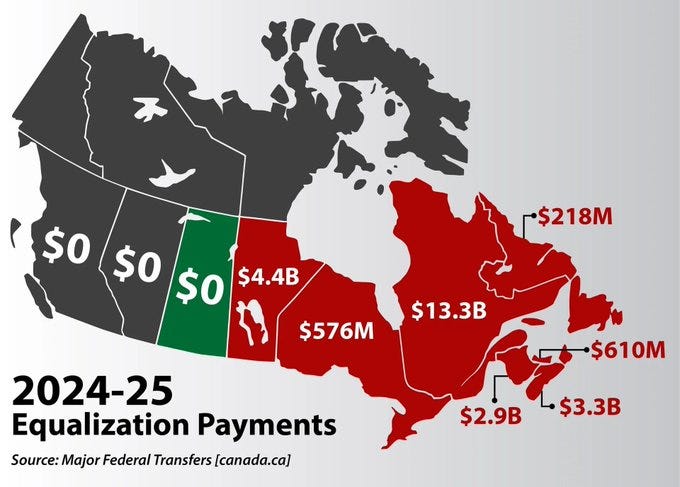

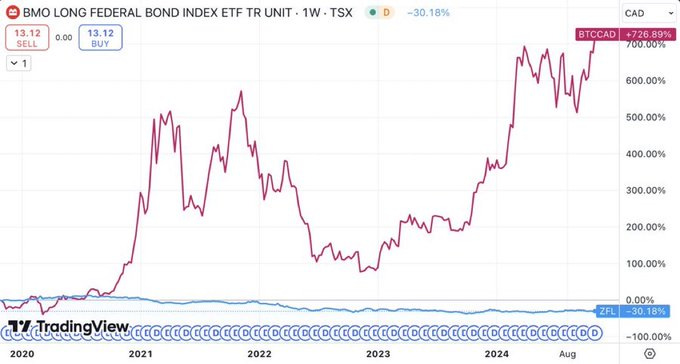

This is exceptionally well thought thru and written. It is THESE things Cdns should be focused on & demanding our leadership address…not elbows up BS !!
Well as an Albertan I know that if the constitutional issues are not addressed then Canada will likely fall as a country.